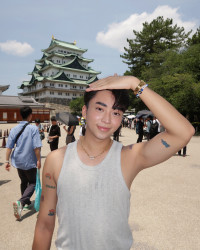
May 20, 2010
Prophet Motive
Visionary trend forecaster Li Edelkoort has helped companies like Coca-Cola, Nissan and Gucci anticipate market shifts and keep ahead of their competitors. In a groundbreaking Tokyo exhibition, she offers up “an archaeology of the future”
By Metropolis
Originally published on metropolis.co.jp on May 2010

Exhibition view - Photo courtesy of 21_21 Design Sight

Photo courtesy of 21_21 Design Sight
The future may be unwritten (as English rock star Joe Strummer once claimed), but in business, seeing the writing on the wall remains the key to survival and success. This is the special province of Li Edelkoort, an international design guru and trend forecaster who helps clients prepare for the future by peering far beyond the myopia of the present. In the fashion and product design worlds, her pronouncements carry so much weight that they risk becoming self-fulfilling prophecies.
Edelkoort’s work is especially relevant to Japan, a country that exists out of the international slipstream. The inherent parochialism of Japanese society can result in companies being wrong-footed by unexpected global trends—witness the move towards budget air travel that doomed Japan Airlines. So it’s no surprise that she recently opened a Japan branch of her consultancy firm Trend Union, complementing existing offices in Paris and New York.
According to Issey Miyake, the legendary fashion designer and a close friend of Edelkoort’s, the relative insularity of Japanese culture also creates dangers for Japan’s young designers. As one of the four directors of Tokyo’s leading 21_21 Design Sight museum, Miyake invited Edelkoort to curate a major exhibition of foreign talents to correct what he sees as the self-satisfied complacency of the local design scene. The result is “Post Fossil: Excavating 21st Century Creation,” a sprawling show with a strangely tribal vibe that features animal shapes, odd natural materials, cleverly recycled objects and rough, unfinished designs.
“I was asked by Issey to do this show as the first foreign curator because he felt that the younger generation were going round in circles with Japanese aesthetics,” Edelkoort tells Metropolis in a sit-down interview following a photo shoot at the museum. “Japanese aesthetics are very beautiful, very powerful, very perfect, but they are starting to lack some energy or air. So he felt that he needed to make a counterpoint, and he said to me the key word is break.”
And “break” the exhibition most certainly does with its daring “Post-Fossil” concept. Not only is this intended to shake up young Japanese designers and broaden their thinking, but the entire show exists as a kind of three-dimensional forecast of the future as seen by Edelkoort.

Atelier van Lieshout, Family Lamp, 2007 - Photo courtesy of Carpenters Workshop Gallery - click image to enlarge
But who exactly is this woman with the piercing blue eyes, who trades on her ability to see deep into the future? Is she a sibyl or a charlatan—or perhaps a mixture of both? And what exactly are the methods she uses to unravel the threads with which the future is woven?
Wielding as much influence as she does, Edelkoort might be seen as a crank who preys off the weak and the gullible. But in reality, the 60-year-old Dutchwoman is a respected resource for major corporations—over the years, Coca-Cola, Nissan, Siemens, Estée Lauder, Lancôme, L’Oréal, Shiseido and Gucci, among others, have counted on her services.
“I have a long track record because I started in the ’80s, and I’ve been good on long-term forecasting,” she says with a charming lack of false modesty. “I’ve been especially good at pre-seeing the U-turns in society. It’s pretty easy to go from year to year in a reasonable, nice economic climate… What makes it very complicated is that some trends come and don’t go. We are now in a period of culture when a thing comes, like manga, and it’s just becoming more and more important, and is developing more and more variations.”
Although employed by hard-headed businessmen, the methodology Edelkoort uses to reach her conclusions is far from scientific, being based largely on her instincts about cultural phenomena.
“The best way to describe it is that I’m doing archaeology of the future,” she says. “I pick up fragments I see here or there—one brief image of a little girl, one photograph of an avant-garde artist, one video, one discussion, one observation. There are several leads, and then on top is my intuition, which tells me my eye is glued to this picture for a reason, and that it’s going to materialize into something important.”
The products that she then passes on to her clients include lecture tours, where she announces the concepts, colors and materials that will be in fashion two or more years down the road; €2,000 trend-forecasting books, which contain analysis and forecasts along with keywords, photos and even samples of textiles; and specific collaborations with companies to develop particular products. In all these cases, her input is expressed poetically rather than condensed into precise mathematical forecasts, leaving her plenty of wriggle room if—heaven forbid!—she gets it wrong.
A perfect example of Edelkoort’s predictive savvy is her work for Nissan, where she accomplished nothing less than introducing the concept of the lifestyle-focused, environmentally friendly automobiles that are now ubiquitous on highways around the world.
“They came to me in 1987 to ask me if I would help to create a scenario to design a small city car,” she recalls. “This was in the heyday of the ’80s, and everything was black and sharp and fast. I said, ‘End of story. We’re going to have to make a U-turn. There’s going to be an ecological crisis, and when this little car hits the road we will find new consumers with new needs so we have to make a car which is almost anti-speed, which sort of gives an idea of safeness and cuddliness.








